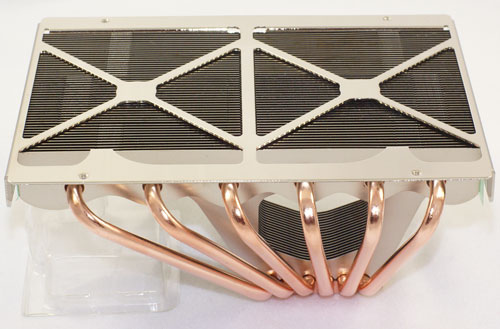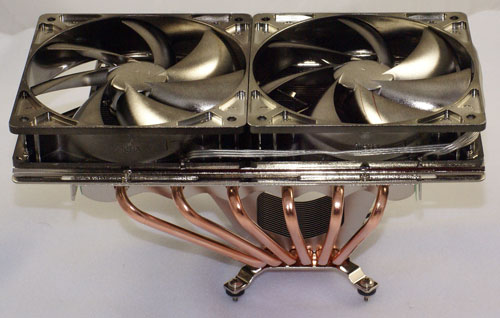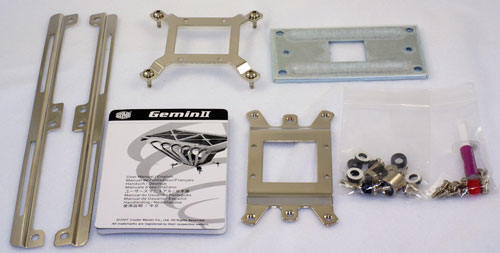Cooler Master GeminII: Performer or Poser?
by Wesley Fink on April 30, 2007 2:00 AM EST- Posted in
- Cases/Cooling/PSUs
Cooler Master Gemini II
Every enthusiast will probably recognize the Cooler Master name. As a leader in providing cooling solutions, Cooler Master has established themselves as a leading name in cases, air cooling, and fans. They also market products such as power supplies, water cooling kits, notebook cooling pads, and specialized chassis for external storage. If it comes to cooling, Cooler Master probably makes a product that competes for your attention.
Cooler Master makes a wide selection of CPU air coolers, ranging from budget alternatives to the stock CPU coolers that come with retail units to exotic high-end solutions. The GeminII currently sits at the top of the Cooler Master air cooling line.

For a cooler as large as the GeminII the packaging is amazingly compact. This is mostly because the Gemini II is shipped without any fans. In fact, Cooler Master claims the cooler can be used for fanless cooling if that is your goal.


The dark grey box is mostly filled with the GeminII heatpipe tower that is packaged in clamshell acrylic to protect the cooler from damage. The base cooler is quite heavy at 847g, which is almost 30 ounces before adding two 120mm fans.

The cooler comes with adapter kits for Intel socket 775 and AMD AM2/754/939/940. Strips for attaching and adjusting two 120mm fans and 8 fan screws for mounting the fans on the slide strips are also included. Preparing the GeminII for mounting is very easy, but you must remove the motherboard completely to mount the heat sink. We say completely remove because the only real way to install the GeminII is by turning the motherboard upside down and screwing the nuts onto the adapter which passes through the motherboard.
It is very important to carefully follow the instructions as there are different thicknesses of washers provided for attaching the GeminII. Some are adhesive and some are just spacers. You will need to make sure you install the correct washers in the correct locations. Our first install did not achieve a very good mating of the cooler base to the CPU top. It is very important to support the motherboard with a small box the height of the Gemini II or the PCIe video card. This allows the board to sit reasonably flat on the table and it makes it easier to get a solid install of the cooler base to the CPU.
While the GeminII is very large and heavy the installation through the board with screw and nuts is very secure. There are easier methods to attach a CPU but we doubt they would be as secure as the method chosen by Cooler Master.
Fans are not included with GeminII, so we chose a wide variety of fans for testing. For more information on the fans used for testing please check the details on page four.
Specifications
Our test system is Intel socket 775, but the Cooler Master GeminII will also mount on any AM2/754/939/940 CPU with the included adapters.
Any 120mm fan will fit the GeminII, regardless of the fan thickness or the post configuration.
Every enthusiast will probably recognize the Cooler Master name. As a leader in providing cooling solutions, Cooler Master has established themselves as a leading name in cases, air cooling, and fans. They also market products such as power supplies, water cooling kits, notebook cooling pads, and specialized chassis for external storage. If it comes to cooling, Cooler Master probably makes a product that competes for your attention.
Cooler Master makes a wide selection of CPU air coolers, ranging from budget alternatives to the stock CPU coolers that come with retail units to exotic high-end solutions. The GeminII currently sits at the top of the Cooler Master air cooling line.

For a cooler as large as the GeminII the packaging is amazingly compact. This is mostly because the Gemini II is shipped without any fans. In fact, Cooler Master claims the cooler can be used for fanless cooling if that is your goal.


The dark grey box is mostly filled with the GeminII heatpipe tower that is packaged in clamshell acrylic to protect the cooler from damage. The base cooler is quite heavy at 847g, which is almost 30 ounces before adding two 120mm fans.

The cooler comes with adapter kits for Intel socket 775 and AMD AM2/754/939/940. Strips for attaching and adjusting two 120mm fans and 8 fan screws for mounting the fans on the slide strips are also included. Preparing the GeminII for mounting is very easy, but you must remove the motherboard completely to mount the heat sink. We say completely remove because the only real way to install the GeminII is by turning the motherboard upside down and screwing the nuts onto the adapter which passes through the motherboard.
It is very important to carefully follow the instructions as there are different thicknesses of washers provided for attaching the GeminII. Some are adhesive and some are just spacers. You will need to make sure you install the correct washers in the correct locations. Our first install did not achieve a very good mating of the cooler base to the CPU top. It is very important to support the motherboard with a small box the height of the Gemini II or the PCIe video card. This allows the board to sit reasonably flat on the table and it makes it easier to get a solid install of the cooler base to the CPU.
While the GeminII is very large and heavy the installation through the board with screw and nuts is very secure. There are easier methods to attach a CPU but we doubt they would be as secure as the method chosen by Cooler Master.
Fans are not included with GeminII, so we chose a wide variety of fans for testing. For more information on the fans used for testing please check the details on page four.
Specifications
Our test system is Intel socket 775, but the Cooler Master GeminII will also mount on any AM2/754/939/940 CPU with the included adapters.
| Cooler Master GeminII Specifications | |
| Dimensions | 175(L) X 124.6W) X 81.5(H)mm (excluding fan) |
| Weight | 847g (excluding fan) |
| Material | Copper and Aluminum with soldered joints |
| Heatpipes | Six |
| Fan Configuration | Supports up to two 120mm fans (side by side) of any thickness |
Any 120mm fan will fit the GeminII, regardless of the fan thickness or the post configuration.










44 Comments
View All Comments
PICBoy - Monday, April 30, 2007 - link
I know it's been a a while since Wesly reviewed the Katana and this space is reserved for the recently reviewed heatsink.But I wanted to know if AT is planning on a review about the "Katana 2" (now available @ FrozenCPU). I hope it's better than the Katana Cu and the regular Katana. I even hope to see it close to the Ninja!
That's all. Thanks!
Rocket321 - Monday, April 30, 2007 - link
I think this is an error at the bottom of page 2.
Wesley Fink - Monday, April 30, 2007 - link
Both editing errors corrected.herbiehancock - Monday, April 30, 2007 - link
I do appreciate the heatsink reviews AT and Wesley do...........but I have some observations to make about them.First, Wesley absolutely gushed over the SilenX fans....and was wowed by the 14dBA rating! Gosh....so quiet!
It certainly is too bad that Wesley did absolutely no research into the fans or testing of them. If he had he'd have found out they are absolutely nothing special and are mediocre at best. SPCR has done an indepth test of the SilenX fans and found their dBA ratings are just hype and bogus....the fans actually created a sound rating of 34dBA or worse....and their air output was bested by comparable fans such as the S-Flex SFF fan lineup....not the monster 110cfm fan that is included in the overly loud ratings, but maybe the SFF21F fan that produces 70cfm at an honest 31dBA. Or use the next level down...the SFF21E...producing 51cfm at an honest 23dBA.
But, then again, when you rate the loudness of your fans by taking sound readings from 1M away from the fan, take them on 3 axes (one on axis with the fan...two off-axis and therefore oblivious to the noise production), and then take the mean of the three readings, I'm sure I could get almost any fan out there to achieve around 14dBA.
Naturally, the sound production of SilenX fans does not address their overly small motors, either. User after user has commented on the fact that after extended use, the small motors of SilenX fans tend to heat up a LOT more than fan motors of more normal sizing. But....when you source your fans from Globe Fan as SilenX does, and Globe is not the best producer of quiet fans, what do you expect?
Second, why even post sound ratings of any of the heatsink/fan combos when they are all drowned out by the noisy power supply? To just show hs after hs sound ratings that are almost all at 47dBA....that's meaningless information. All we know is that the power supply is making that much noise. Nothing about how much each hs/fan combo is producing.
My suggestion is to test the hs/fan combo in question mounted on a mb separately from a power supply's contamination. You don't have to have a darned thing heating it up to make the fan run at full speed to see how loud the fan is at full tilt. Alternatively, there are methods of producing a heating device a heatsink can mount to to test cooling capacity and sound production at various levels of cooling....all without having the contamination of the pwoer supply's fan.
yyrkoon - Tuesday, May 1, 2007 - link
AM I missing something here, or was this review concerning a new heatsink, or a fan, that some other sites are 'waring' over ? I am really, really, getting bored with you whiners, that feel it nessisary, to spread your unhappyness all over the internet.In case it has not been made obvious to you, and the other whiners, that the AT staff view themselves as a real world application type reviewer, I DO NOT CARE how quiet the fan really is, so long as it is quieter than the rest of the components in the system( I know I am not alone here). I am sure, the specifications AT gave out, where copied directly from the box, or given to them by the manufactuer. Now, if you really feel it nessisary to know the true specifications, go read about the fan at some other site, that has nothing better to do, than whine about how quiet a fan really is.
Let me know if the above text is too complicated to understand, and I'll be happy to throw in a few 'goo goo's', and 'gaa gaa's', just for you.
xsilver - Tuesday, May 1, 2007 - link
maybe a good compromise can be made on this whole fan noise issue.maybe AT can test the HSF as a separate setup to the system(psu).
With the graph though they can have a line going through it for where the system noise should be; so you have the noctua/sflex etc. with lower bars but then a great big red line at 47/38.3 db saying "your psu noise is most likely here you knob!"
that should put all the naysayers to rest.
yyrkoon - Wednesday, May 2, 2007 - link
Maybe each individual AT reader could send the AT staff $100usd daily for their time ? Possible, but not likely.Seriously though, as an outsider looking in, I do not think it is in ATs best interrest to do so. Each seperate test takes time, and time is money . . .
stromgald - Monday, April 30, 2007 - link
As a member of the SPCR community, I haven't heard anything about the issue with small motors. Also, there are several very good Globe fans in terms of quiet computing. Check SPCR's recommended list. I believe there are one or two Globe fans on there.Most SPCR members will tell you that SilenX aren't the best, but they certainly aren't the worst. Misrepresentation of noise and airflow levels are rampant in the industry and has been demonstrated by several websites. It's nothing new or particularly bad that SilenX misreperesents their numbers. The rift between SilenX and SPCR does not come from their hardware, but a marketing ploy SilenX tried on SPCR forums.
Even as a silent PC enthusiast, I don't expect AT to do SPCR level testing. I just want consistent testing for all products, and testing that is close to real world applications as possible, with discrepancies from real-life application pointed out clearly.
The drown-out issue is important though. Even though most environments have a sound 'floor', I think AT should consider using a quieter PSU (Seasonic or Corsair) or passive graphics card when doing cooling tests. A reference 'everything off', quiet room reading of the sound meter would also be greatly appreciated in the noise readings, and wouldn't be hard to do.
strikeback03 - Tuesday, May 1, 2007 - link
5th paragraph on the Noise page of the review.
Wesley Fink - Monday, April 30, 2007 - link
It is clear SilenX and some SPCR readers had a war some time ago and feelings still run deep. We were not part of that war. We can only report what we found, which was the SilenX fan cooled well and improved performance at below system noise floor on the heatsinks we tested with it. Performance was improved over the stock cooler on some heatsinks and not on some others.As we have said repeatedly, there is a place for testing fans in isolation separated from a real world power supply. You will not find those kinds of fan tests at AT. We are revising our test bed to further lower noise, but noise measurements will still be with a balanced system capable of enthusiast level performance.
Those interested in silence only need to look at other sites that specialize in that approach.